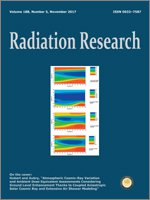Astronauts traveling to Mars will be exposed to chronic low doses of galactic cosmic space radiation, which contains highly charged, high-energy (HZE) particles. 56Fe-HZE-particle exposure decreases hippocampal dentate gyrus (DG) neurogenesis and disrupts hippocampal function in young adult rodents, raising the possibility of impaired astronaut cognition and risk of mission failure. However, far less is known about how exposure to other HZE particles, such as 28Si, influences hippocampal neurogenesis and function. To compare the influence of 28Si exposure on indices of neurogenesis and hippocampal function with previous studies on 56Fe exposure, 9-week-old C57BL/6J and Nestin-GFP mice (NGFP; made and maintained for 10 or more generations on a C57BL/6J background) received whole-body 28Si-particle-radiation exposure (0, 0.2 and 1 Gy, 300 MeV/n, LET 67 KeV/μ, dose rate 1 Gy/min). For neurogenesis assessment, the NGFP mice were injected with the mitotic marker BrdU at 22 h postirradiation and brains were examined for indices of hippocampal proliferation and neurogenesis, including Ki67 , BrdU , BrdU NeuN and DCX cell numbers at short- and long-term time points (24 h and 3 months postirradiation, respectively). In the short-term group, stereology revealed fewer Ki67 , BrdU and DCX cells in 1-Gy-irradiated group relative to nonirradiated control mice, fewer Ki67 and DCX cells in 0.2 Gy group relative to control group and fewer BrdU and DCX cells in 1 Gy group relative to 0.2 Gy group. In contrast to the clearly observed radiation-induced, dose-dependent reductions in the short-term group across all markers, only a few neurogenesis indices were changed in the long-term irradiated groups. Notably, there were fewer surviving BrdU cells in the 1 Gy group relative to 0- and 0.2-Gy-irradiated mice in the long-term group. When the short- and long-term groups were analyzed by sex, exposure to radiation had a similar effect on neurogenesis indices in male and female mice, although only male mice showed fewer surviving BrdU cells in the long-term group. Fluorescent immunolabeling and confocal phenotypic analysis revealed that most surviving BrdU cells in the long-term group expressed the neuronal marker NeuN, definitively confirming that exposure to 1 Gy 28Si radiation decreased the number of surviving adult-generated neurons in male mice relative to both 0- and 0.2-Gy-irradiated mice. For hippocampal function assessment, 9-week-old male C57BL/6J mice received whole-body 28Si-particle exposure and were then assessed long-term for performance on contextual and cued fear conditioning. In the context test the animals that received 0.2 Gy froze less relative to control animals, suggesting decreased hippocampal-dependent function. However, in the cued fear conditioning test, animals that received 1 Gy froze more during the pretone portion of the test, relative to controls and 0.2-Gy-irradiated mice, suggesting enhanced anxiety. Compared to previously reported studies, these data suggest that 28Si-radiation exposure damages neurogenesis, but to a lesser extent than 56Fe radiation and that low-dose 28Si exposure induces abnormalities in hippocampal function, disrupting fear memory but also inducing anxiety-like behavior. Furthermore, exposure to 28Si radiation decreased new neuron survival in long-term male groups but not females suggests that sex may be an important factor when performing brain health risk assessment for astronauts traveling in space.
How to translate text using browser tools
25 September 2017
Whole-Body Exposure to 28Si-Radiation Dose-Dependently Disrupts Dentate Gyrus Neurogenesis and Proliferation in the Short Term and New Neuron Survival and Contextual Fear Conditioning in the Long Term
Cody W. Whoolery,
Angela K. Walker,
Devon R. Richardson,
Melanie J. Lucero,
Ryan P. Reynolds,
David H. Beddow,
K. Lyles Clark,
Hung-Ying Shih,
Junie A. LeBlanc,
Mara G. Cole,
Wellington Z. Amaral,
Shibani Mukherjee,
Shichuan Zhang,
Francisca Ahn,
Sarah E. Bulin,
Nathan A. DeCarolis,
Phillip D. Rivera,
Benjamin P. C. Chen,
Sanghee Yun,
Amelia J. Eisch
ACCESS THE FULL ARTICLE

Radiation Research
Vol. 188 • No. 5
November 2017
Vol. 188 • No. 5
November 2017




